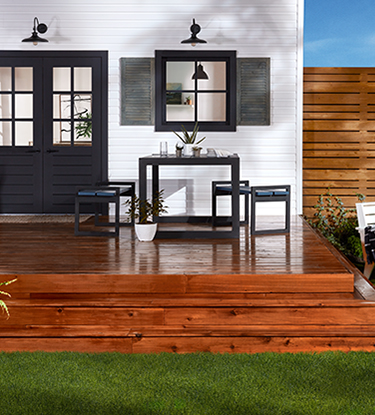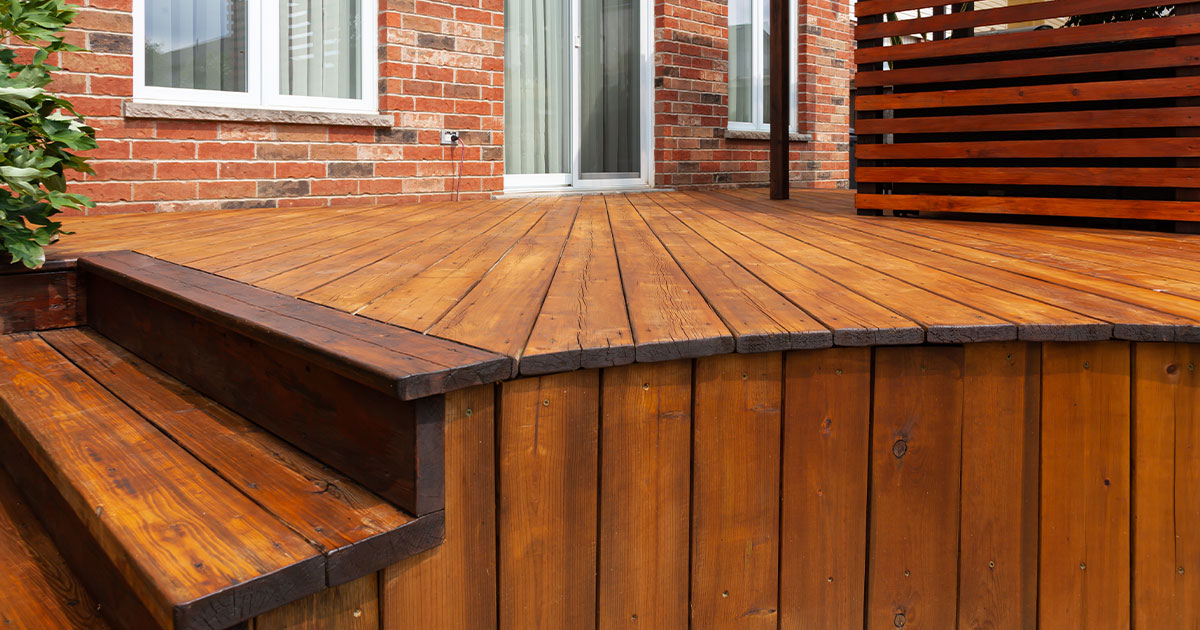A Comprehensive Guide to Different Sorts Of Deck Staining Techniques for Ultimate Protection and Visual Appeals
In the realm of deck maintenance, the art of staining stands as a critical step towards both preserving the stability of your exterior room and enhancing its aesthetic allure. As we browse via the complex globe of deck staining techniques, one begins to value the nuanced strategies that can make all the distinction in between an average finish and a flawless one. From the option of the ideal tarnish kind to the precise application methods, each aspect plays a crucial duty in attaining that ideal balance between protection and visual appeals. Join us as we uncover the keys behind accomplishing the supreme deck staining results-- a trip where every brushstroke shapes not just the surface area, however the very significance of your outside sanctuary.
Recognizing Different Sorts Of Stains
Numerous types of discolorations are typically made use of in the process of deck discoloration to achieve various visual and protective results. Transparent discolorations are perfect for showcasing the all-natural grain of the wood while supplying marginal security versus UV rays and moisture. On the various other hand, semi-transparent discolorations provide an equilibrium between color improvement and protection, enabling some timber grain to reveal through. For a much more nontransparent finish that offers optimum defense against the elements, strong discolorations are the preferred option. These discolorations come in a variety of colors and properly conceal the wood grain.
Toners include a hint of color to the wood while giving marginal defense, making them appropriate for newer decks with less wear. Recognizing the features and advantages of each type of stain is crucial for achieving the wanted appearance and sturdiness for your deck.
Choosing the Right Stain Shade
When thinking about the looks of your deck staining project, the selection of discolor color plays a crucial duty in improving the protective top qualities of the chosen stain kind (Water-Based Stains). The color you choose can dramatically affect the overall appearance of your deck, as well as its capacity to endure the elements gradually
When selecting a tarnish color, it's important to take into consideration the existing color pattern of your home's outside. Balancing the deck tarnish with the general visual of your building can produce a natural and visually enticing outdoor area. Additionally, the color of your deck tarnish can influence the temperature level of the deck surface area; darker colors often tend to absorb more warmth, while lighter colors show sunshine and remain cooler.
Moreover, the kind of timber you are staining will likewise influence how the discolor shade appears. Different timber varieties can interact with the discolor in different means, potentially changing the last shade. It's advisable to evaluate the discolor on a tiny, low-profile area of the deck to guarantee the shade ends up as wanted before waging the entire job.
Preparing Your Deck for Discoloration
To make certain a lasting and successful deck discoloration job, detailed preparation of the deck surface is important. Begin by cleaning up the deck completely to eliminate dust, crud, mold, and any kind of old tarnish or end up. Make use of a deck cleaner or a combination of water and cleaning agent along with a stiff brush or stress washing machine to scrub the surface area tidy. After cleansing, enable the deck to completely dry totally before proceeding to the next step.
Examine the deck for any damaged or rotten boards that need to be replaced. Hammer down any extending nails and sand any harsh locations to guarantee a smooth surface for discoloration. Look for any type of loose barriers or steps that might require tightening or repair.
As soon as the deck is clean, completely dry, and in great repair, take into consideration applying a timber brightener to restore the deck's all-natural shade and open the wood pores for much better stain penetration. Secure any kind of nearby plants, furnishings, or surface areas with plastic sheeting prior to continuing with the staining process. Correct preparation is crucial to attaining a professional-looking finish and making best use of the longevity of your deck discolor.
Using Discoloration With Various Methods
For a remarkable and professional coating, the method of applying discolor plays a critical role in improving the look and longevity of your deck. There are several methods you can use to make certain a reliable application of stain.
It is ideal for intricate areas and getting to in between deck boards. Back-brushing after rolling is advised to also out the discolor and work it into the timber for far better infiltration.
Splashing is another preferred method, offering rate and ease of application, specifically for big deck locations. Whichever method you choose, making certain appropriate prep work and complying with supplier guidelines will certainly assist attain a durable and gorgeous tarnish finish on your deck.

Maintaining and Re-staining Your Deck
When it comes to re-staining your click this deck, the frequency depends on numerous elements such as the kind of discolor made use of, the climate in your location, and how much wear and tear your deck experiences. Usually, it is recommended to re-stain your deck every 2-4 years to keep its protection click for more and appearances.
Before re-staining, make certain the deck is clean, completely dry, and devoid of any type of previous tarnish residue. Fining sand might be required to ravel rough areas or get rid of old stain that is flaking. Select a high-grade stain that fits your deck's product and offers the preferred degree of protection. Apply the discolor equally utilizing the proper method talked about earlier in this overview to ensure a lasting and lovely coating - Beautiful Deck. By remaining aggressive with maintenance and re-staining, you can delight in a aesthetically enticing and well-protected deck for years to come.
Conclusion
To conclude, understanding the different types of deck stains, choosing the right shade, properly preparing the deck, using tarnish with numerous methods, and re-staining the deck and preserving are necessary actions for supreme security and aesthetic appeals. By complying with these steps, you can ensure that your deck remains in leading problem for many years to find.
Additionally, the shade of your deck tarnish can influence the temperature of the deck surface; darker shades have a tendency to absorb even more warmth, while lighter colors reflect sunshine and stay cooler.
It's recommended to test the tarnish on a little, inconspicuous location of the deck to make sure the color transforms out as preferred before continuing with the entire project.
